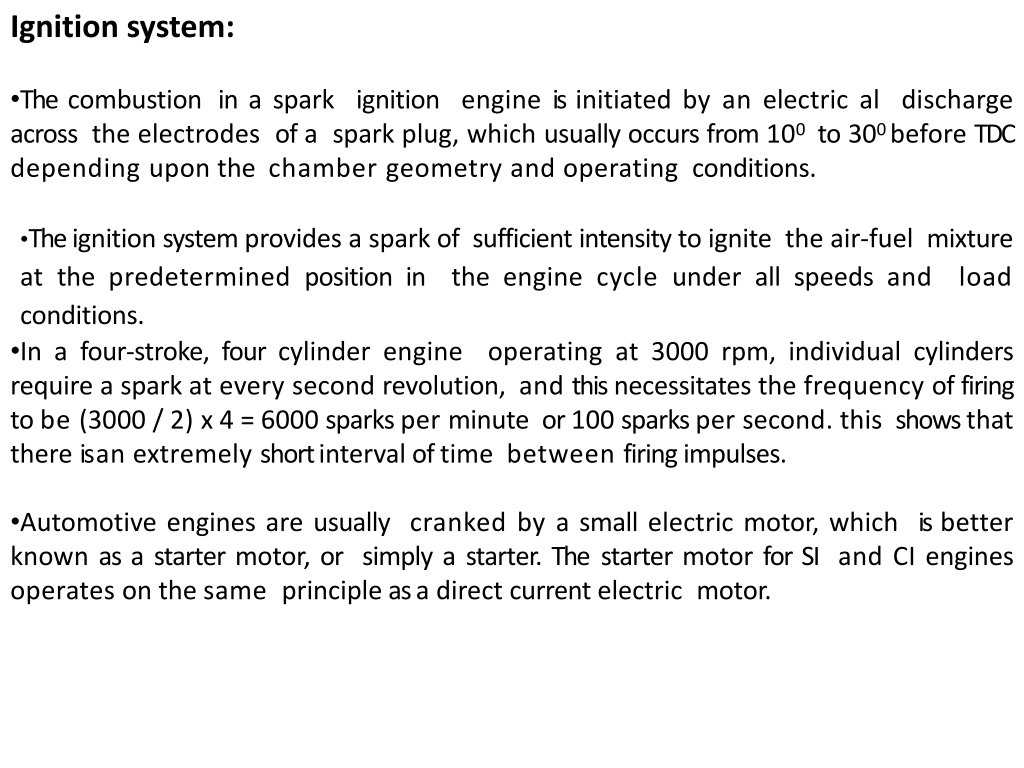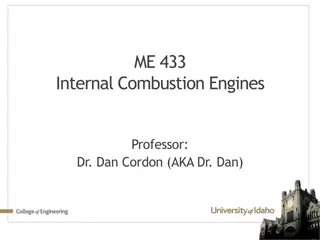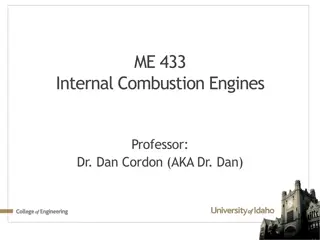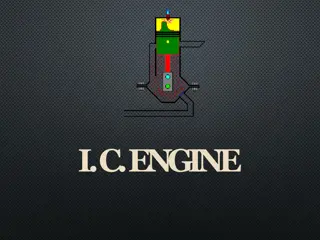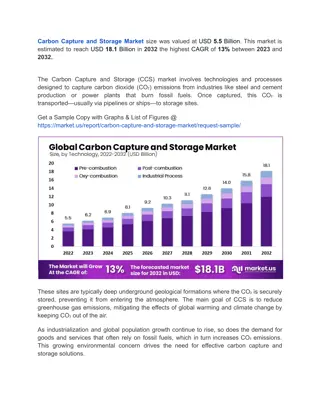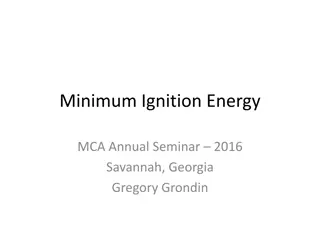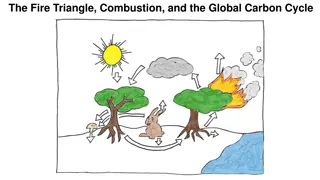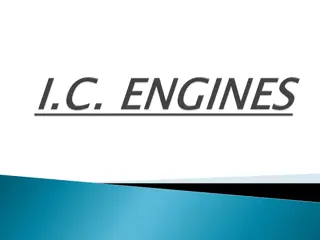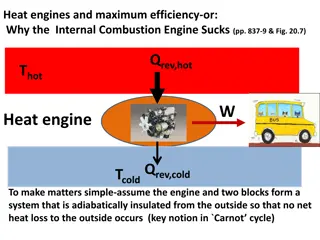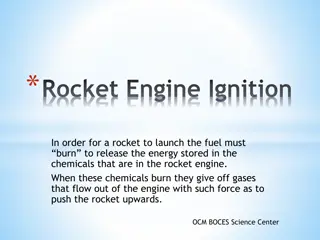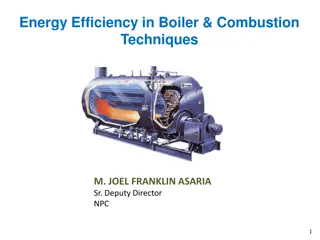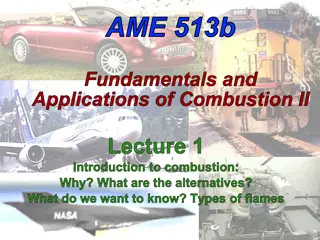Understanding the Ignition System in Internal Combustion Engines
The ignition system in spark ignition engines initiates combustion through electric discharge across the spark plug electrodes. It ensures proper ignition timing for efficient engine operation at various speeds and loads. Modern ignition systems include battery, magneto, and electronic ignition types, each serving the critical function of generating sparks to ignite the air-fuel mixture. Components like coils, capacitors, and breaker points work together to create high-voltage electricity needed for combustion.
Uploaded on Sep 19, 2024 | 0 Views
Download Presentation

Please find below an Image/Link to download the presentation.
The content on the website is provided AS IS for your information and personal use only. It may not be sold, licensed, or shared on other websites without obtaining consent from the author. Download presentation by click this link. If you encounter any issues during the download, it is possible that the publisher has removed the file from their server.
E N D
Presentation Transcript
Ignition system: The combustion in a spark ignition engine is initiated by an electric al discharge across the electrodes of a spark plug, which usually occurs from 100 to 300 before TDC depending upon the chamber geometry and operating conditions. The ignition system provides a spark of sufficient intensity to ignite the air-fuel mixture at the predetermined position in the engine cycle under all speeds and load conditions. In a four-stroke, four cylinder engine operating at 3000 rpm, individual cylinders require a spark at every second revolution, and this necessitates the frequency of firing to be (3000 / 2) x 4 = 6000 sparks per minute or 100 sparks per second. this shows that there is an extremely short interval of time between firing impulses. Automotive engines are usually cranked by a small electric motor, which is better known as a starter motor, or simply a starter. The starter motor for SI and CI engines operates on the same principle as a direct current electric motor.
Modern ignition system: The development of high speed, high compression internal combustion engine requires a reliable high-speed ignition system. This is met by a high-tension ignition system that uses a spark plug as the source of ignition. The electric al energy to the spark plug is supplied by one of the following systems and is termed accordingly. Battery ignition system Magneto ignition system Electronic ignition system 1. 2. 3.
The primary circuit consists of the battery, ammeter, ignition switch, primary coil winding, capacitor, and breaker points. The functions of these components are: Battery : provides the power to run the system. Ignition switch : allows the driver to turn the system on and off . Primary coil : produces the secondary coil. the magnetic field to create the high voltage in Breaker points : a mechanic al switch that act s as the triggering mechanism. Capacitor :protects the points from burning out. Contact Breaker : Breaking the primary circuiting of ignition coil. Induction Coil : induction coil is iron core wrapped with primary and secondary windings.
The secondary circuit converts magnetic induction into high voltage electricity to jump across the spark plug gap, firing the mixture at the right time. The functions of the components are: Secondary coil : the part of the coil that creates the high voltage electricity Coil wire : a highly insulated wire to take the high voltage to the distributor cap : a plastic cap which goes on top of the distributor, to hold the high tension wires in the right order : spins around on the top of the distributor shaft, and distributes the spark to the right spark plug : another highly insulated wire that takes the high voltage from the cap to theplugs : take the electricity from the wires, and give it an air gap in the combustion chamber to jump across, mixture Distributor cap Rotor Spark leads Spark plugs plug to light the
2.Magneto ignition system: The high powered, high speed spark racing cars use magneto ignition system. The basic components of a magneto ignition system consist of a magneto, breaker points, capacitor, ignition switch, distributor,spark plug leads, and spark plugs. ignition engines like aircraft, sports and Magneto can either be rotating armature type or rotating magneto type. In the former, the armature consisting of the primary and secondary windings all rotate between the poles of a stationary magneto, while in the second type, the magneto revolves and the windingsare kept stationary.
Magneto ignition system (with rotating magnets)
Aspect Source of energy Battery ignition system Conservation chemical energy into electrical energy Magneto ignition system Conservation of kinetic energy into electrical energy Primary current starting Obtained from battery Obtained from magnet Easy start, because battery gives good spark Good spark, thus no problem Poor spark at start & lower speed of engine Poor spark at lower speed, thus engine runs erratically Low speed High speed Current for spark decrease as engine speed increased Current for spark increases with speed of engine, thus excellent spark at high speed System is light weight and compact, thus less space is required Very less and cheap maintenance, due to absence of battery Two wheelers scooters, racing cars, air craft etc., Space required System is bulky and require more space maintenance System requires more maintenance and it difficult to start engine when battery is in discharged In cars, light commercial vehicles Application
The disadvantage of the mechanic al system is that it requires regular adjustment to compensate for wear, and the opening of the contact breakers, which is responsible for spark timing, is subject to mechanic al variations. In addition, the spark voltage is also dependent on contact effectiveness, and poor sparking may lower the engine efficiency. Electronic ignition system has solved these problems. In this system, the contact breaker points are replaced by an angular sensor of some kind - either optical, where a vaned rotor breaks a light beam, or more commonly using a hall effect sensor, which responds to a rotating magnet mounted on a suitable shaft. The sensor output processed by a suitable circuitry is then used to trigger a switching device such as a thyristor, which switches a large flow of current through the coil. The rest of the system (distributor and spark plugs) remains the same as that of the mechanic al system. The lack of moving parts compared with the mechanic al system leads to greater reliability and longer service intervals. In some older cars, it was usually possible to retrofit an electronic ignition system in place of the mechanic al one.
SPARK PLUG: the spark plug is a part of the ignition system which sends high voltage into the combustion chamber to create a spark which causes the compressed air fuel mixture to burn. the main parts are as follows: 1. Terminal: the top of the spark plug contains a terminal which is connected to a high tension wire through which high- current voltage current from the ignition system flows. 2. Insulator: the main function of the insulator is to provide the mechanical support for the center electrode,( preventing escape of high voltage from the electrode). The most widely used insulator is made of aluminium ceramic. The aluminium ceramic offers high heat conduction ratio, electrical insulation, corrosion resistance and durability against sudden cooling. 3. Steel shell: the steel shell has threads that allow the spark plug to be tightened into the combustion chamber and a hexagonal fitting is provided on the outside of the shell. 4. Center electrode: the center electrode is connected to the terminal through an internal wire(resistor) . The tip can be made of a nickel alloy containing very small amount of manganese, silicon and chrome.
5. Ground or side electrode: the side electrode is made from high nickel steel and is welded to the side of the steel shell. The side electrode also runs very hot, especially on projected nose plugs. 6. Seal: the spark plug mounted in the combustion chamber is subjected to extremely high pressures. The seal ensure that there is no leakage from the combustion chamber.
BATTERY: A battery in automobiles is an electrical device which produces electricity(current) through chemical action inside it. The battery does not store electricity as electrons but stores as in the chemical form. The electrical energy produced in the battery by the chemical reaction that occurs between two dissimilar plates that are immersed in an electrolyte solution. The automotive batteries are rechargeable, they can also convert an electrical current into chemical energy and stores that energy until it is needed. TYPES OF BATTERIES: The following four types of batteries are used in automobiles: 1. Lead- acid battery 2. Alkaline- battery, which may be i) Nickel-iron type, ii)nickel-cadmium type and iii) silver-zinc type 3) Non- conventional battery which may be i)Zinc-air battery, ii) sodium-sulphur type and lithium- chlorine type 4) Dry charge battery.
CONSTRUCTION OF BATTERY: 1. Battery Box: battery box is made of hard rubber having inside three or six cell compartments. The capacity of the each cell is 2 volts. The bunch of battery plates having positive and negative plates are separators and place in compartments. Then by placing cover it is covered by cell cover. This cover has three holes for negative, positive and third for vent plug. 2. Battery plates: Each cell has set of positive and negative plates and each are separated by separator. There is one more plate of negative than positive in each cell. These plates are made of lead in the form of grids. Positive plates lead peroxide (PbO2)is pasted and has chocolate color while negative plate lead antimony is pasted and of grey color. 3. separator: separators are placedin between negative and positive plates. Separators made of wood or plastic are place so that plates should not touch each other. 4. Electrolyte: it is made 64% of distilled water(H2O) and 36% of sulphuric acid (H2SO4). 5. Vent Plug: when battery charge or discharge then chemical action takes place and gases formed and to release the gases a small holes are made in it.
Charging system: The automotive storage battery is not capable of supplying the current for a long period of times, as per demand of electrical system. Thus every vehicle is equipped with a charging system. The basic purpose of the charging system is to convert the mechanical energy into electrical(electricity) energy to recharge the battery and to operate the other electrical systems.
The following main component are consist in charging system: 1. Battery: the charging system supplies direct current to the battery for charging. During charging, the battery changes electrical energy from the generator into chemical energy. The active materials of the battery are stored. The battery also act as a shock absorber or voltage stabilizer in the system to prevent damage to sensitive components in the electrical vehicles electrical system. 2. Generator: It is the most important component of the charging system. It converts mechanical energy from engine into electrical energy. The mechanical energy is transferred from the engine to generator by grooved drive on a pulley arrangement. When rotated , it generates electricity by electromagnetic induction. 3. Drive belt: the generator is driven from the engine by means of a drive belt. 4. Voltage regulator: It controls the amount of electrical energy produced. Without a regulator the generator will always operate at its highest output. This may damage certain components and overcharge the battery. The regulator controls the generator output to prevent overcharging or undercharging.
5. Charging indicator( lamp or gauge):It indicates whether the system is being charged or not. The charging indicator device most commonly used as simple on/off warning lamp. It is normally off , it lights when the ignition is turned on for a check of the lamp circuit. 6. Ignition switch: It is used for starting the engine. When the ignition switch is in on position, battery current energizes the generator.
STARTING SYSTEM: The internal combustion engine used in automobile is not capable of self starting. The starting system rotates the engine until it can continue itself. The starting system is a combination of mechanical and electrical parts that work together to start the engine. the starting system is design to convert electrical energy from battery into mechanical energy in the starting motor. This motor then transfers the mechanical energy, through gears, to the flywheel on the engines crankshaft. The basic starting system consists of the following parts: 1. Battery, 2. Ignition switch, 3. Magnetic switch( either an electrical relay or a solenoid), 4. Starter motor, 5. Safety switch.
